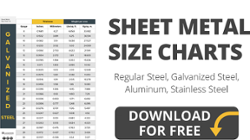Most professions use symbols as a way to communicate instructions quickly. These symbols are quicker than either speaking or writing out the instructions on how a weld is supposed to be. While these symbols may seem to be mysterious undecipherable hieroglyphs which can never be translated, these weld symbols are actually quite easy to learn given enough practice.
The horizontal line of the weld symbol is called a reference line and all of the other welding symbols will be tied to it. The instructions for the weld are found along the reference line as it saves time from reading out a long list of instructions. The arrow connects the reference line to the joint which needs to be welded and the reference line will always be horizontal and will always be a required element.
The arrow line connects to the reference line and points to where the weld is supposed to take place. Sometimes there is a circle around where the reference line and the arrow line meet, called the 'All The Way Around' symbol. This is used to indicate that the welding is supposed to go all the way around a joint. If there is a flag line where the reference line and arrow line meet, then that indicates a field weld.
If there is a break in the arrow, that means there is other preparation that is required, or beveling is needed.
Why Is A Tail Added To The Basic Weld Symbol?
The tail of the weld symbol is used to indicate the cutting process. It also holds information about the procedures and specifications of a particular weld. In some cases, other supplementary information will be provided in the tail of the weld. If there is no additional information to be added, then a tail will not be used in the symbol.
Basic Welding Symbols
There are welding symbols which indicate which weld type needs to be used. These are:- Bevel groove: One side is chamfered (to cut a furrow in) and the other is left square. The arrow points towards what is supposed to be chamfered.
- Fillet weld: Used to make lap, corner, and T joints.
- Flare Bevel groove weld: Used to join something round or curved to something lat.
- Flare-V groove weld: Joins two rounded or curved pieces.
- Groove weld: Used to make edge-to-edge joints. Many ways to make a groove weld.
- J-Groove: The edge of one piece is concave and the other is left square.
- Plug and slot weld: Joins overlapping pieces.
- Square Groove: Groove is created by either a slight separation or a tight fit.
- U-groove: The edges on both pieces are concave.
- V-groove: The edges on both pieces are chamfered to create the groove.
Here at Blackstone Advanced Technologies, we do a variety of work for the industrial, military, scientific, and transportation industries. But we also love to educate others about welding. Check out our blog to read anything about if it is possible to do sheet metal fabrication in copper, or if you are interested in learning about plasma arc welding applications.
Click here to download your weld specifications e-book.
Did you find our blog a helpful tool for what you were looking for? Feel free to share on Facebook, LinkedIn or Twitter by using the super-easy share buttons on the right! Scroll down farther for mobile viewers.
What are some of your most used welding symbols? Leave a comment below.


